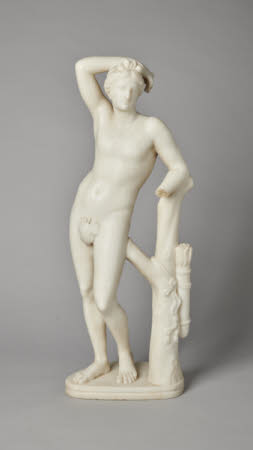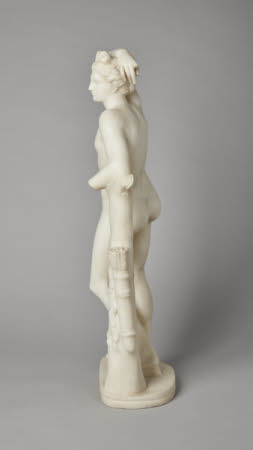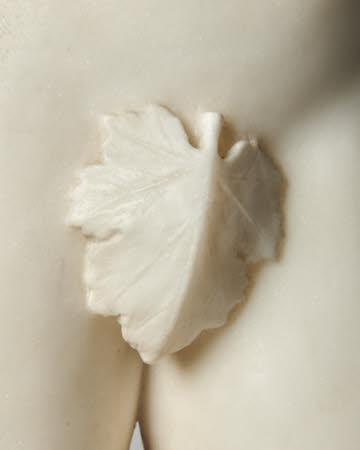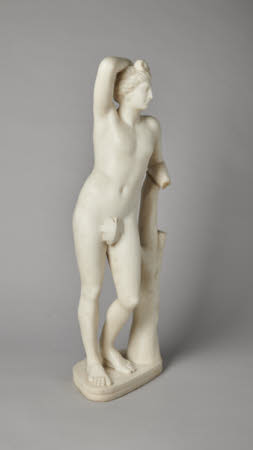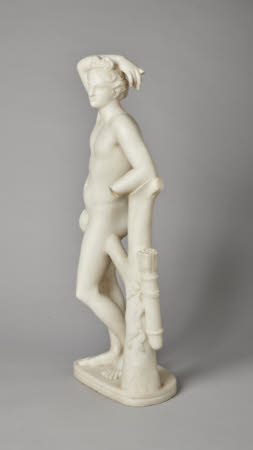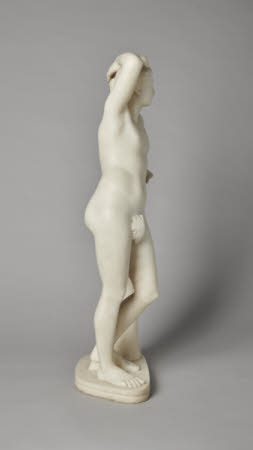Apollino
Italian (Florentine) School
Category
Art / Sculpture
Date
c. 1840 - 1900
Materials
Carrara marble
Measurements
660 x 274 x 190 mm
Place of origin
Florence
Order this imageCollection
Mount Stewart, County Down
NT 1220133
Summary
Sculpture, marble; the Apollino (‘little Apollo’); Italian, perhaps Florence; c. 1850-1900. A marble reduction of an antique Roman marble statue in the Uffizi galleries in Florence, representing Apollo, god of lyric poetry and music. He is depicted naked, leaning upon a tree trunk over which is slung his quiver of arrows. One of two versions of the Apollino at Mount Stewart.
Full description
A marble copy of the Roman marble statue known as the Apollino or ‘little Apollo’, which has been one of the highlights of the Tribuna in the Uffizi galleries since the late eighteenth century. A lithe naked figure of the god who stands with his weight upon his right foot, his torso slightly twisted as he looks towards his left. He leans with his left elbow upon a tree stump; his left hand, now broken off, once held part of a bow. Apollo’s right arm is raised and rests on the back of his head. Hair arranged into a bow at the front. From the tree stump hangs a quiver containing arrows. Integral oval base with recessed moulding. Apollo, god of the sun, and also of music and lyric poetry, was sometimes also depicted as a hunter, with a bow and a quiver of arrows. He used his bow to slay the serpent Python with ‘a thousand arrows’ in an episode recounted in Ovid's Metamorphoses (I. 439-49), and in another story in which Apollo and his sister Diana slew the children of Niobe, who had boasted that she had outdone their mother, Leto, in her number of offspring. In the Roman marble statue in the Uffizi, generally thought to be a copy of a fourth-century B.C. Greek sculpture of a type known as the Apollo Lykeios or ‘Lycian Apollo’ (Mansuelli 1958-61, I, pp, 74-76, no. 46; Haskell and Penny 1981, pp. 146-48, no. 7), the bow that Apollo would originally have held in his left hand and the quiver on the tree trunk refer to these episodes. Otherwise, though, the sculpture is a display of languid male beauty. It may have been discovered in the seventeenth century, but was recorded in 1704 in the Villa Medici in Rome, in a compendium of famous statues in Rome published by Paolo Alessandro Maffei. The illustration suggests that most of the restorations seen on the sculpture today had probably already been done by that time. In 1769-70 the statue was moved to Florence, along with the celebrated group of sculptures of Niobe’s children. It was shortly afterwards placed in the Tribuna of the Uffizi, where it may still be seen today. Although interest would greatly diminish later in the nineteenth century, during the eighteenth and early nineteenth centuries the Apollino was one of the most highly regarded sculptures in the Uffizi, even thought to compare with the Venus de’Medici. The poet Percy Bysshe Shelley wrote especially lyrically on the figure, praising the ‘spirit-like lightness, the softness, the flowing perfection of these forms.’ Shelley went on ‘The countenance though exquisite lovely and gentle is not divine. There is a womanish vivacity of winning yet passive happiness and yet a boyish inexperience exceedingly delightful. Through the limbs there appears to flow a spirit of life which gives them lightness… The neck is long yet full and sustains the head with its profuse and knotted hair as if it needed no sustaining.’ (Shelley 1879, p. 37, no. XLVIII). This is the smaller of two copies of the Apollino at Mount Stewart, and is a faithful run-of-the-mill reproduction, probably made quite well into the nineteenth century. It is about half the size of the statue in Florence. The other larger sculpture (NT 1542338) is not so much a copy as an adaptation, with the figure swathed in drapery and other variations. Jeremy Warren September 2022
Provenance
On loan to the National Trust from Lady Mairi Bury (1921-2009), from 1976; accepted by HM Government in lieu of Inheritance Tax and allocated to the National Trust, 2013.
Makers and roles
Italian (Florentine) School, sculptor Roy Coles, sculptor
References
Shelley 1879: Harry Buxton Forman, ed., Notes on Sculptures in Rome and Florence together with a Lucianic fragment and a criticism of Peacock’s poem “Rhododaphne”, by Percy Bysshe Shelley, London 1879 Mansuelli 1958-61: Guido Mansuelli, Galleria degli Uffizi. Le sculture, 2 vols., Rome 1958-61 Haskell and Penny 1981: Francis Haskell and Nicholas Penny, Taste and the Antique, The Lure of Classical Sculpture 1500 - 1900, New Haven and London, 1981, pp. 146-48, no. 7.
